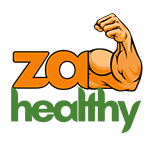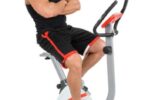Introduction
Welcome to the ultimate guide to shoulder workouts! Whether you aim to build strength, enhance muscle definition, or simply improve your overall fitness, focusing on your deltoids is key. In this comprehensive blog, we’ll delve into targeted exercises for the overall shoulder, front deltoid, and lateral deltoid muscles. Get ready to transform your upper body with these effective workouts.
Overall Shoulder Strength: The Foundation of a Powerful Upper Body
The cable overhead press is a multifaceted exercise that targets the anterior deltoids, or front shoulder muscles, and offers several benefits for those looking to enhance their upper body strength and aesthetics.
Why Include the Cable Overhead Press in Your Routine?
Constant Muscle Tension
One of the primary advantages of using cables is the constant tension they provide throughout the exercise. This continuous load can lead to more muscle fiber recruitment and potentially better growth compared to exercises with variable tension, like free weights.
Core Engagement
The cable overhead press also engages your core muscles. As you press the handles overhead, your core must work to stabilize your body, especially if you incorporate a twist in your torso during the movement. This added core engagement helps to improve your overall balance and stability.
Unilateral Strength Development
Performing the cable overhead press one arm at a time allows you to focus on unilateral strength. This can help correct muscle imbalances between sides and ensure that both shoulders are equally strong and developed.
Cable Overhead Press
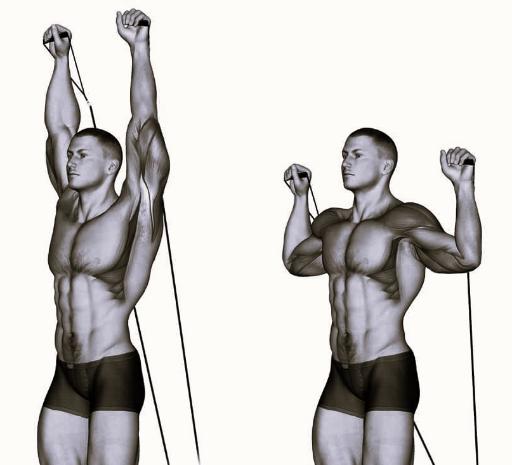
How to Perform the Cable Overhead Press
- Setup: Attach a single grip handle to a low cable pulley.
- Starting Position: Stand up straight, grasping the handle with one arm. Your palm should face forward, and your feet should be shoulder-width apart for stability.
- The Press: Squat down slightly, then stand back up while twisting your torso away from the working arm and press the cable overhead.
- The Descent: Lower the handle back to the starting position with control, untwisting your torso as you do so.
- Repetition: Complete the desired number of reps with one arm before switching to the other arm.
Tips for Maximizing Effectiveness
- Posture: Keep your head and chest up throughout the exercise to maintain proper alignment and maximize shoulder engagement.
- Control: Avoid using momentum to lift the weight. Move the handle deliberately to ensure that your deltoids are doing the work.
- Progression: Start with a lighter weight to master the form, then gradually increase the weight as you become more comfortable with the movement.
By incorporating the cable overhead press into your shoulder routine, you can expect to see improvements in both the size and strength of your anterior deltoids, as well as enhanced core stability. Remember to focus on form and control to get the most out of this effective exercise.
Dumbbell Push Press
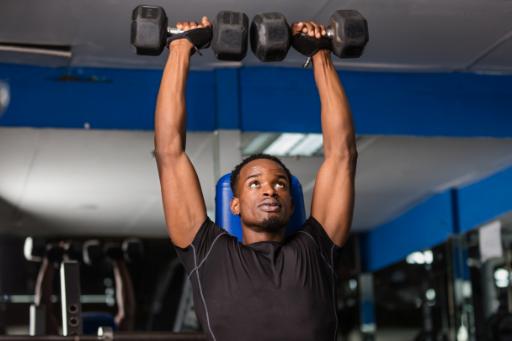
The Dumbbell Push Press is a dynamic compound exercise that engages multiple muscle groups, providing a full-body workout that builds strength, power, and endurance. It’s an efficient movement that combines the overhead press with a lower-body push, making it a staple in strength and conditioning programs.
Muscles Targeted by the Dumbbell Push Press
When you perform the dumbbell push press, you’re not just working your shoulders; you’re engaging a host of muscles throughout your body:
- Deltoids: The primary movers for the pressing action.
- Triceps: Assist in extending the elbows to drive the weights overhead.
- Core: Stabilizes the torso throughout the movement.
- Glutes and Hamstrings: Power the initial upward momentum.
- Quads: Help extend the knees and hips to generate force.
Step-by-Step Guide to the Dumbbell Push Press
- Starting Position: Stand with feet shoulder-width apart, holding a dumbbell in each hand at shoulder level, elbows pointing forward.
- The Dip: Initiate a slight bend in your knees, keeping your torso upright.
- The Drive: Explosively extend your legs, using the momentum to help press the dumbbells overhead.
- The Lockout: Fully extend your arms, locking out the elbows with the dumbbells directly over your shoulders.
- The Return: Lower the dumbbells back to shoulder level with control, preparing for the next repetition.
Tips for Perfecting Your Form
- Elbow Position: Keep your elbows under the dumbbells throughout the lift to ensure efficient force transfer.
- Breathing: Exhale forcefully as you drive the weights up to aid in the exertion.
- Foot Placement: Maintain a solid base with your feet flat on the ground to maximize stability.
- Controlled Descent: Resist the temptation to drop the weights quickly; lower them with control to maximize muscle engagement and safety.
Common Mistakes to Avoid
- Overarching the Back: Keep your core tight to prevent excessive lower back arching.
- Uneven Press: Ensure both arms are moving symmetrically to avoid imbalances and potential injury.
- Rushing the Movement: Focus on the quality of each rep rather than speed to build true strength and power.
As you become more proficient with the dumbbell push press, you can increase the weight, add more repetitions, or incorporate variations such as the single-arm push press to challenge your body in new ways.
Kettlebell Military Press
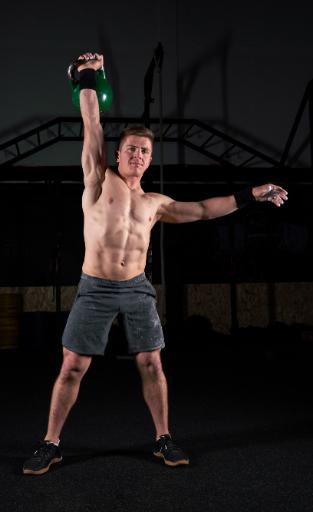
The Kettlebell Military Press stands out as a potent exercise for building robust and resilient shoulders. It’s a move that demands attention to detail and offers a wealth of benefits for those dedicated to mastering it.
Why the Kettlebell Military Press?
- Full Shoulder Engagement: This exercise targets the entire shoulder girdle, emphasizing the deltoids while also engaging the triceps and upper back.
- Postural Benefits: Regular practice can enhance posture by strengthening the muscles that support upright positioning.
- Functional Strength: The movement patterns involved mimic real-world activities, translating to improved functional strength.
Executing the Kettlebell Military Press with Precision
- Starting Position: Stand with feet shoulder-width apart, kettlebells resting on the front of your shoulders, palms facing forward.
- The Press: Exhale as you press the kettlebells straight overhead, locking out your arms and maintaining a neutral wrist position.
- The Descent: Inhale as you carefully lower the kettlebells back to the starting position, readying for the next rep.
Technique Tips for the Kettlebell Military Press
- Wrist Alignment: Keep your wrists straight throughout the lift to prevent strain and ensure proper force transfer.
- Core Stability: Engage your core to maintain balance and protect your lower back during the press.
- Controlled Movement: Resist the urge to rush. Execute each rep with control to maximize muscle activation and minimize injury risk.
Variations to Spice Up Your Routine
- One-Arm Press: Challenge your stability and address imbalances by pressing one kettlebell at a time.
- Seated Press: Sit down to remove leg drive from the equation, placing more emphasis on the shoulders.
- Bottoms-Up Press: Flip the kettlebell upside down for an extra test of grip strength and control.
As you grow stronger, you can increase the weight of the kettlebells, add more reps, or incorporate pauses at the top of the press to further challenge your muscles.
Dumbbell Arnold Press
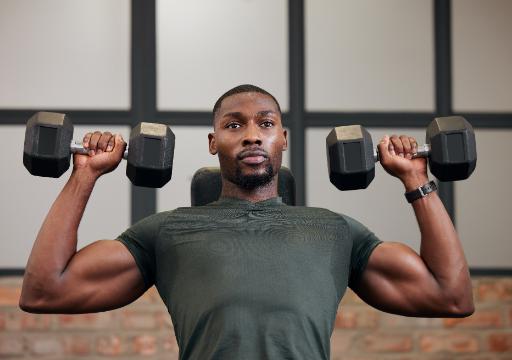
The Dumbbell Arnold Press is a unique variation of the traditional shoulder press that incorporates rotation, adding a dynamic component to the movement. This exercise was popularized by Arnold Schwarzenegger and is renowned for its ability to target multiple aspects of the deltoids.
Anatomy of the Dumbbell Arnold Press
The Arnold Press engages several key muscle groups:
- Deltoids: With three heads (anterior, lateral, and posterior), this muscle group is the primary focus, responsible for lifting and rotating the arm.
- Triceps: These muscles assist in extending the arm at the elbow during the press.
- Trapezius: While not a primary mover, the traps support the movement of the shoulders and upper back.
Performing the Dumbbell Arnold Press
- Starting Position: Sit or stand with a dumbbell in each hand at shoulder height, palms facing you.
- The Rotation and Press: As you press the dumbbells overhead, rotate your arms so that your palms face forward at the top of the movement.
- The Descent: Reverse the motion, rotating your palms back towards you as you lower the dumbbells to the starting position.
Tips for Mastery
- Controlled Rotation: Ensure a smooth transition as you rotate your palms; this is where the magic happens.
- Stable Core: Engage your core throughout the exercise to maintain balance and protect your spine.
- Even Tempo: Maintain a consistent pace during both the ascent and descent to maximize muscle engagement.
Variations and Progressions
- Seated vs. Standing: Performing the press seated isolates the shoulders more while standing engages the core for stability.
- Weight and Reps: Start with lighter weights to perfect your form, then gradually increase as you build strength.
The Benefits of the Arnold Press
- Comprehensive Deltoid Activation: By rotating during the press, you’re hitting the deltoids from various angles.
- Enhanced Shoulder Stability: The rotation element promotes shoulder stability and mobility.
- Aesthetic Improvement: Regular inclusion can lead to well-rounded, aesthetically pleasing shoulder development.
